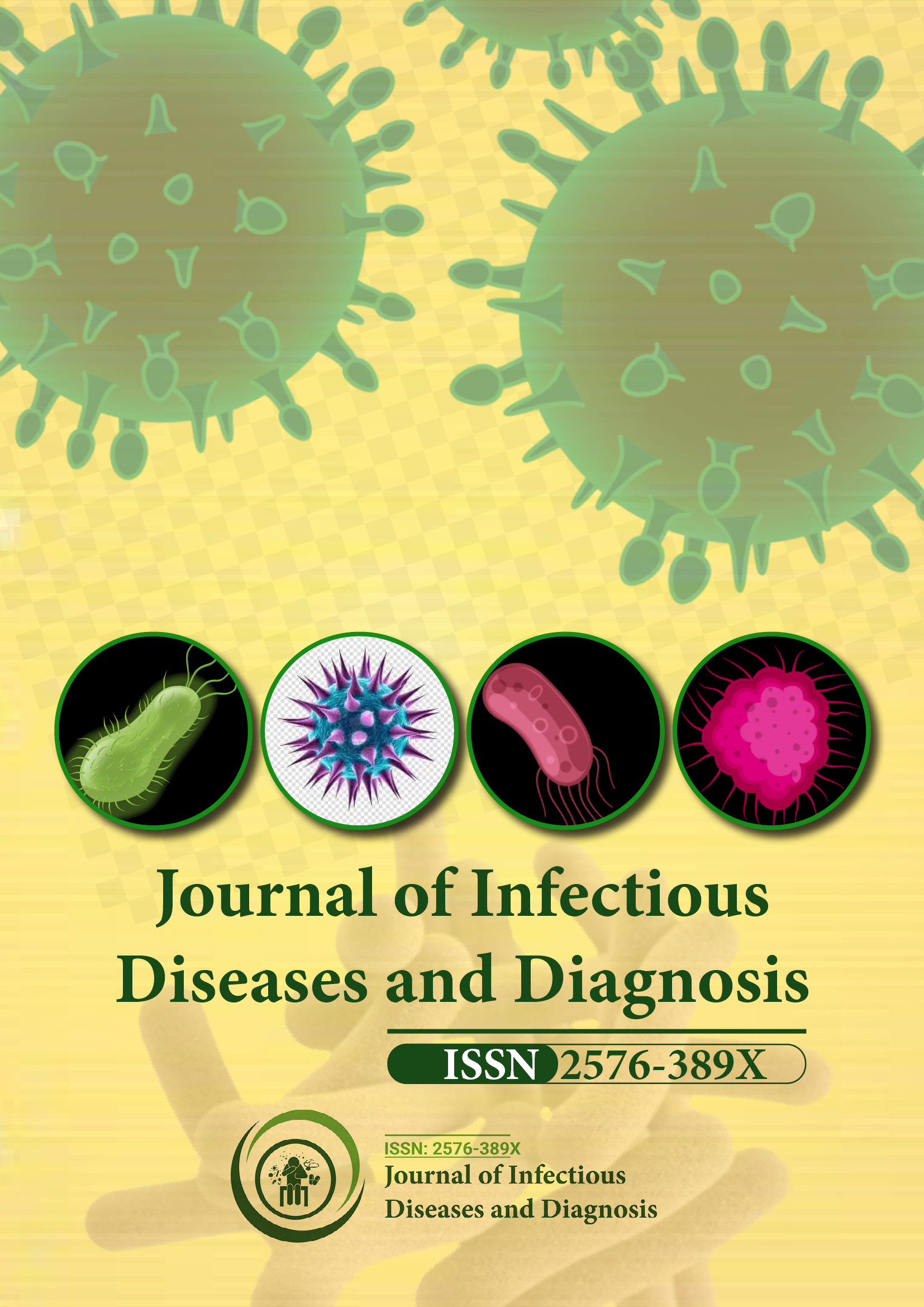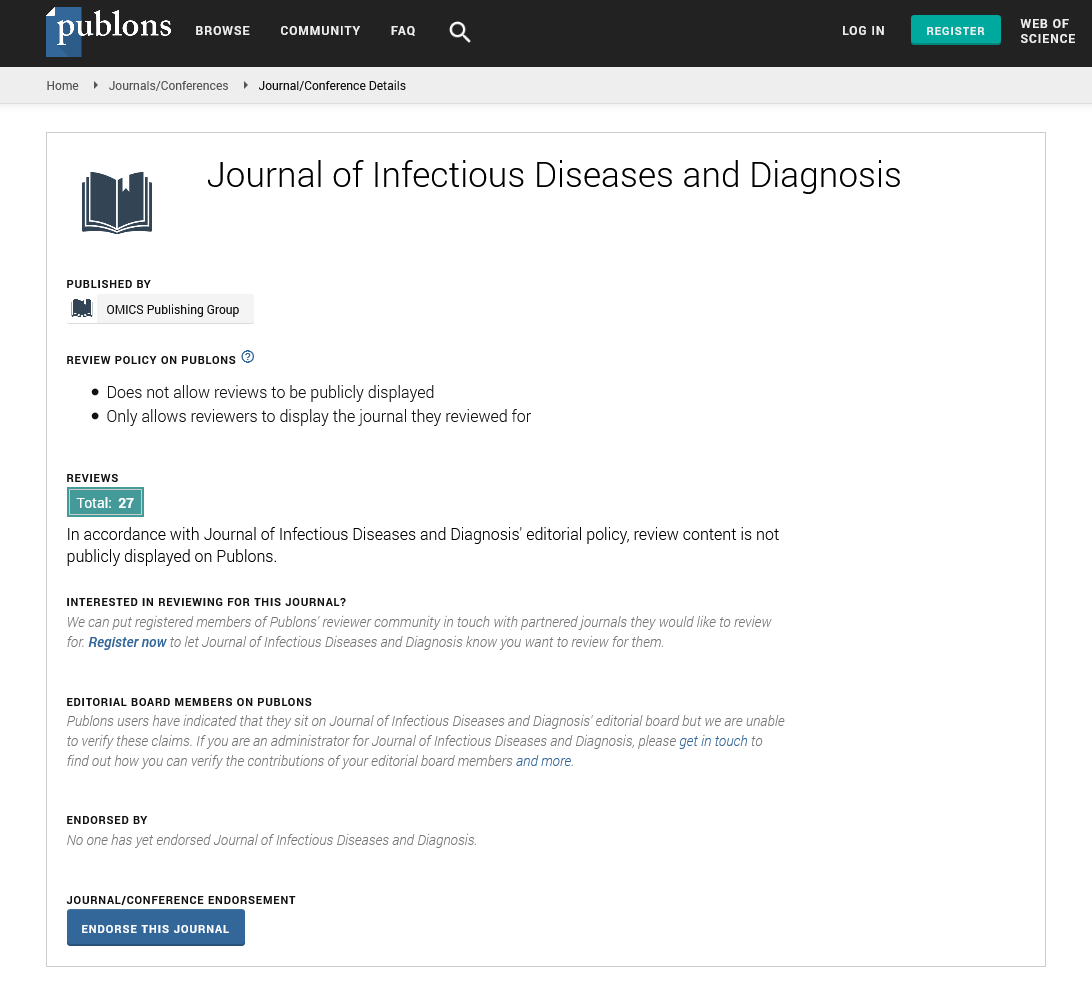Indexed In
- RefSeek
- Hamdard University
- EBSCO A-Z
- Publons
- Euro Pub
- Google Scholar
Useful Links
Share This Page
Journal Flyer

Open Access Journals
- Agri and Aquaculture
- Biochemistry
- Bioinformatics & Systems Biology
- Business & Management
- Chemistry
- Clinical Sciences
- Engineering
- Food & Nutrition
- General Science
- Genetics & Molecular Biology
- Immunology & Microbiology
- Medical Sciences
- Neuroscience & Psychology
- Nursing & Health Care
- Pharmaceutical Sciences
Short Communication - (2024) Volume 9, Issue 4
Understanding the Impact of Multi-Species Plasmodium Infections on Malaria Transmission
Yoo Sunbin*Received: 03-Jun-2024, Manuscript No. JIDD-24-26514; Editor assigned: 05-Jun-2024, Pre QC No. JIDD-24-26514 (PQ); Reviewed: 19-Jun-2024, QC No. JIDD-24-26514; Revised: 26-Jun-2024, Manuscript No. JIDD-24-26514 (R); Published: 03-Jul-2024, DOI: 10.35248/2576-389X.24.09.278
About the Study
The co-infection of the four major Plasmodium species like Plasmodium falciparum, Plasmodium vivax, Plasmodium malariae, and Plasmodium ovale presents unique challenges and complexities in understanding malaria epidemiology and control. This study examines how co-infection affects parasite densities and gametocyte carriage, key factors in the transmission dynamics of malaria [1].
Co-infection with multiple Plasmodium species is not uncommon in regions where malaria is endemic. Such infections can alter the course of disease, influence treatment outcomes, and impact the spread of malaria within communities [2]. Each Plasmodium species has distinct biological characteristics and interacts differently with the human host and mosquito vector. Understanding these interactions, especially in co-infection scenarios, is critical for effective malaria management [3].
One of the primary concerns with co-infection is its impact on parasite densities. The density of Plasmodium parasites in the blood is a major determinant of disease severity and transmission potential. Studies have shown that co-infections can lead to varying outcomes in terms of parasite densities. In some cases, one species may dominate and suppress the others, leading to lower overall densities of the suppressed species [4]. For example, Plasmodium falciparum is often more virulent and can outcompete other species, potentially reducing their densities. However, this interaction is not always straight forward. There are instances where the presence of multiple species leads to higher overall parasite burdens, which can increase the clinical presentation of malaria and complicate treatment strategies [5].
Gametocyte carriage is another critical aspect influenced by co-infection. Gametocytes are the sexual forms of the parasite responsible for transmission from humans to mosquitoes. The density and viability of gametocytes in the human host directly affect the likelihood of mosquito infection and subsequent spread of malaria. Co-infection can modify gametocyte dynamics in several ways. For instance, the immune response affected by one species might influence the development and survival of gametocytes of another species [6]. There is evidence suggesting that co-infection can either enhance or reduce gametocyte carriage, depending on the specific interactions between the species involved.
The presence of multiple Plasmodium species in a single host can also influence the host’s immune response. The human immune system's response to malaria is complex and involves both innate and adaptive mechanisms. Co-infection can lead to cross-reactive immune responses where antibodies or immune cells targeting one species may affect the other species [7]. This immune modulation can impact parasite densities and gametocyte carriage, although the exact mechanisms remain an area of active research.
Additionally, co-infection poses significant challenges for diagnosis and treatment. Standard diagnostic tests may not accurately detect all species present, leading to under diagnosis and mistreatment. Treatment protocols often target the dominant species, which might not be effective against the co- infecting species [8]. This can result in suboptimal treatment outcomes and contribute to the persistence of malaria in endemic regions. There is a pressing need for diagnostic tools and treatment regimens that consider the possibility of co- infection and are effective against multiple species simultaneously.
Understanding the dynamics of co-infection is also essential for malaria control programs. The transmission potential of co- infected individuals might differ from those infected with a single species. Control strategies that do not account for co- infection could be less effective, particularly in regions where multiple Plasmodium species co-circulate [9]. Integrated approaches that consider the epidemiology of all major Plasmodium species are necessary to reduce the overall malaria burden.
Research into the effects of co-infection on parasite densities and gametocyte carriage is ongoing. Recent studies have utilized advanced molecular techniques and mathematical modeling to better understand these interactions [10]. However, there remain significant gaps in knowledge, particularly regarding the long-term implications of co-infection on malaria transmission and control.
Conclusion
In conclusion, the co-infection of the four major Plasmodium species presents a complex interplay of factors that influence parasite densities and gametocyte carriage. These interactions have significant implications for disease severity, treatment outcomes, and malaria transmission dynamics. Addressing the challenges posed by co-infection requires a comprehensive approach that includes improved diagnostic tools, customized treatment protocols, and integrated control strategies. Continued research in this area is vital for developing effective interventions and ultimately reducing the global burden of malaria.
References
- Cubas-Atienzar AI, Kontogianni K, Edwards T. Limit of detection in different matrices of 19 commercially available rapid antigen tests for the detection of SARS-CoV-2. Sci Res Pathol. 2021;11:18313.
[Crossref] [Google Scholar] [PubMed]
- Zhou H, Wang C, Rao J, Chen L, Ma T, Liu D. The impact of sample processing on the rapid antigen detection test for SARS-COV-2: Virus inactivation, VTM selection, and sample preservation. Biosafety and Health. 2021;3(5):238-243.
[Crossref] [Google Scholar] [PubMed]
- Toppings NB, Oberding LK, Lin YC, Evans D, Pillai DR. The role of sub genomic RNA in discordant results from reverse transcription-polymerase chain reaction tests for COVID-19. Arch Pathol Lab Med. 2022;146(7):805-813.
[Crossref] [Google Scholar] [PubMed]
- Pollock NR, Savage TJ, Wardell H, Lee R, Mathew A, Stengelin M. Correlation of SARS-CoV-2 nucleocapsid antigen and RNA concentrations in nasopharyngeal samples from children and adults using an ultrasensitive and quantitative antigen assay. J Clin Microbiol. 2021;59(4):e03077-e04020.
[Crossref] [Google Scholar] [PubMed]
- Kanji JN, Bailey A, Fenton J, Lindsay LR, Dibernardo A, Toledo NPL. Stability of SARS-COV-2 IGG in multiple laboratory conditions and blood sample types. J Clin Virol. 2021;142:104933.
[Crossref] [Google Scholar] [PubMed]
- Shurrab FM, Al-Sadeq DW, Amanullah F, Younes SN, Al-Jighefee H, Younes N. Effect of multiple freeze-thaw cycles on detection of anti-SARS-CoV-2 IgG antibodies. J Med Microbiol. 2021;70(8).
[Crossref] [Google Scholar] [PubMed]
- Kellman BP, Baghdassarian HM, Pramparo T. Multiple freeze-thaw cycles lead to a loss of consistency in poly(A)-enriched RNA sequencing. BMC genomics. 2021;22(1):1-5.
[Crossref] [Google Scholar] [PubMed]
- Lee YN, Chen LK, Ma HC, Yang HH, Li HP, Lo SY. Thermal aggregation of SARS-CoV membrane protein. J Virol Methods. 2005;129(2):152-161.
[Crossref] [Google Scholar] [PubMed]
- Durante M, Schulze K, Incerti S, Francis Z, Zein S, Guzman CA. Virus irradiation and COVID-19 Disease. Front Phys. 2020;8:565861.
- Rokushika S, Murakami F, Senda T, Hatano H. Inactivation of ribonuclease A in aqueous solution by ionizing radiation. J Radiat Res. 1972;13(4):221-229.
[Crossref] [Google Scholar] [PubMed]
Citation: Sunbin Y (2024) Understanding the Impact of Multi-Species Plasmodium Infections on Malaria Transmission. 9:278.
Copyright: © 2024 Sunbin Y. This is an open-access article distributed under the terms of the Creative Commons Attribution License, which permits unrestricted use, distribution, and reproduction in any medium, provided the original author and source are credited.

